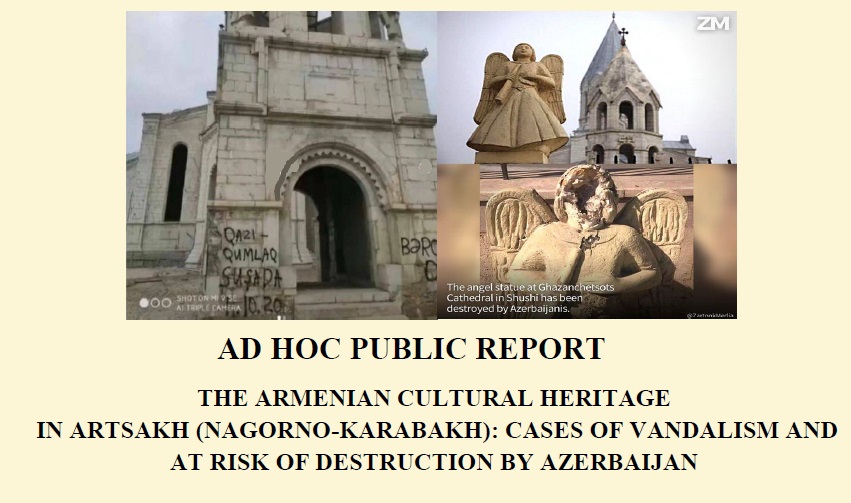in Russian – https://aga-tribunal.info/ombudsman-26-1-2021/
AD HOC PUBLIC REPORT THE ARMENIAN CULTURAL HERITAGE IN ARTSAKH (NAGORNO-KARABAKH): CASES OF VANDALISM AND AT RISK OF DESTRUCTION BY AZERBAIJAN
Source: web site of the Ombudsman of the Republic of Artsakh, January 26, 2021. Full Report in PDF (106 pages) – here.
There are an estimated 4,000 Armenian cultural sites, including 370 churches, 119 fortresses and other historical and cultural monuments in the Artsakh (Nagorno-Karabakh) Republic. The churches date from the 4th to the 21st century. Its valuable archaeological sites, most notably the ancient city of Tigranakert of Artsakh, date back to the 1st c. BC – 13th c. AD period.
Under the trilateral statement on ceasefire of November 9, 2020 between the Republic of Armenia, the Republic of Azerbaijan and the Russian Federation, at least 1,456 overwhelmingly Armenian historical and cultural immovable prominent monuments have been fallen under Azerbaijani control, including 161 Armenian churches,the archaeological sites of Tigranakert, Azokh Paleolithic cave, the Nor Karmiravan tombs, Mirik, Keren, and architectural monuments such as palaces, bridges, and historic quarters (see Annex 2). In addition, in the territories which came under Azerbaijani control, there were 8 state museums and galleries with 19311 exhibits (see Annex 1), as well as “Shushi Carpet Museum” and “Shushi Armenian Money Museum” operating on a private basis.
There are serious concerns over the preservation of these historical sites under Azerbaijani control. Given Azerbaijan’s practice of systematic destruction of Armenian cultural heritage in its territories over the last several decades, these concerns are not misplaced. Two flagrant examples are (1) the total destruction of the ancient Armenian cemetery of Julfa in Nakhichevan between 1997-2006, in which a total of 28,000 monuments (including 89 medieval churches; 5,840 unique hand-carved khachkars (cross-stones) and 22,000 ancient tombstones were destroyed; and (2) the destruction of Armenian monuments of the Tsar village in the Karvachar (Kelbajar) region. Moreover, despite the short time of control, there are already a number of known cases of vandalism against Armenian cultural heritage in Artsakh in the places that were occupied by Azerbaijan during September 27-November 9 war.
Historical revisionism by Azerbaijan is rampant in the region, which has been carried out through systemic “Albanization” of Armenian cultural property since the 1950s. In an effort to strengthen its ties to these lands, Azerbaijan revises and rewrites history by claiming that the Armenian churches and cross-stones belong to Caucasian Albanians, and that Caucasian Albanians are Azerbaijani peoples’ ancestors. The goal is to eradicate Armenian peoples’ historical roots to the region and thereby diminish their entitlement to live in and govern these areas while fabricating an Azerbaijani historical presence.
This report aims to highlight the urgency required in taking steps to protect Armenian cultural heritage in the Republic of Artsakh (Nagorno-Karabakh) and prevent its destruction once under Azerbaijani control.
After a ceasefire has been established on November 9, 2020, UNESCO made a proposal both to Armenia and Azerbaijan to send an independent mission of experts to draw a preliminary inventory of significant historical and cultural heritage sites in and around Nagorno-Karabakh as a first step towards the effective safeguarding of the region’s heritage. For the same purpose, the members of the intergovernmental Committee of the Hague Convention of 1954 for the Protection of Cultural Property in the Event of Armed Conflict and its Second Protocol (1999), adopted a declaration on December 11, 2020 and welcomed UNESCO’s initiative and confirmed the need for a mission to take stock of the situation regarding cultural properties in and around Nagorno-Karabakh. The Committee requested each of the parties to render the mission possible.
Despite the urgency of the matter as acknowledged by UNESCO, Azerbaijani Government creates an obstacle for the mission to arrive by not responding to the request.
The first part of this report sets out the deliberate targeting of Armenian cultural heritage during the recent war, in violation of the 1954 Hague Convention, to which both the Republic of Azerbaijan and the Republic of Armenia are parties, and the second part looks at Azerbaijan’s state-sponsored propaganda aimed at appropriating Armenian cultural heritage as its own and/or cleansing any traces of Armenians in regions under Azerbaijani control.
CONTENT
Full Report in PDF (106 pages) – here.
INTRODUCTION ………….. 3
TARGETED ATTACKS ON ARMENIAN CULTURAL AND HISTORICAL MONUMENTS ………………. 5
1.1. Holy Saviour Ghazanchetsots Cathedral in Shushi (1888) ………. 5
1.2. Saint John the Baptist Church (Known as “Kanach Zham”) (1818), Shushi . 11
1.3. Tigranakert of Artsakh (1st c. BC – 13th c. AD) ……… 13 1.4. Other Cases of Azerbaijani Attacks and Vandalism Against Armenian Cultural Monuments ………………. 17
APPROPRIATION OF ARMENIAN CULTURAL AND HISTORICAL HERITAGE BY USE OF DISINFORMATION ……. 20 3. THE RULES OF INTERNATIONAL LAW TO RESPECT AND PROTECT CULTURAL PROPERTY .. 29
CONCLUSION …………….. 31
ANNEX 1 – CULTURAL MOVABLE STATE HERITAGE FALLEN UNDER AZERBAIJANI CONTROL AS A RESULT OF MILITARY AGGRESSION AGAINST THE REPUBLIC OF ARTSAKH …. 32
ANNEX 2 – LIST OF OVERWHELMINGLY ARMENIAN HISTORICAL AND CULTURAL IMMOVABLE PROMINENT MONUMENTS FALLEN UNDER AZERBAIJANI CONTROL AS A RESULT OF MILITARY AGGRESSION AGAINST THE REPUBLIC OF ARTSAKH ….. 33
LISTS OF HISTORICAL AND CULTURAL IMMOVABLE PROMINENT MONUMENTS IN THE REGIONS FALLEN UNDER AZERBAIJANI CONTROL
IN ASKERAN REGION …….. 33
IN HADRUT REGION ……….. 40
IN KASHATAGH REGION .. 59
IN MARTAKERT REGION .. 73
IN MARTUNI REGION …… 77
IN SHUSHI REGION ……. 81
IN NOR SHAHUMYAN (KARVACHAR) REGION … 98

One thought on “The Armenian cultural heritage in Artsakh: cases of vandalism and at risk of desctruction by Azerbaijan”